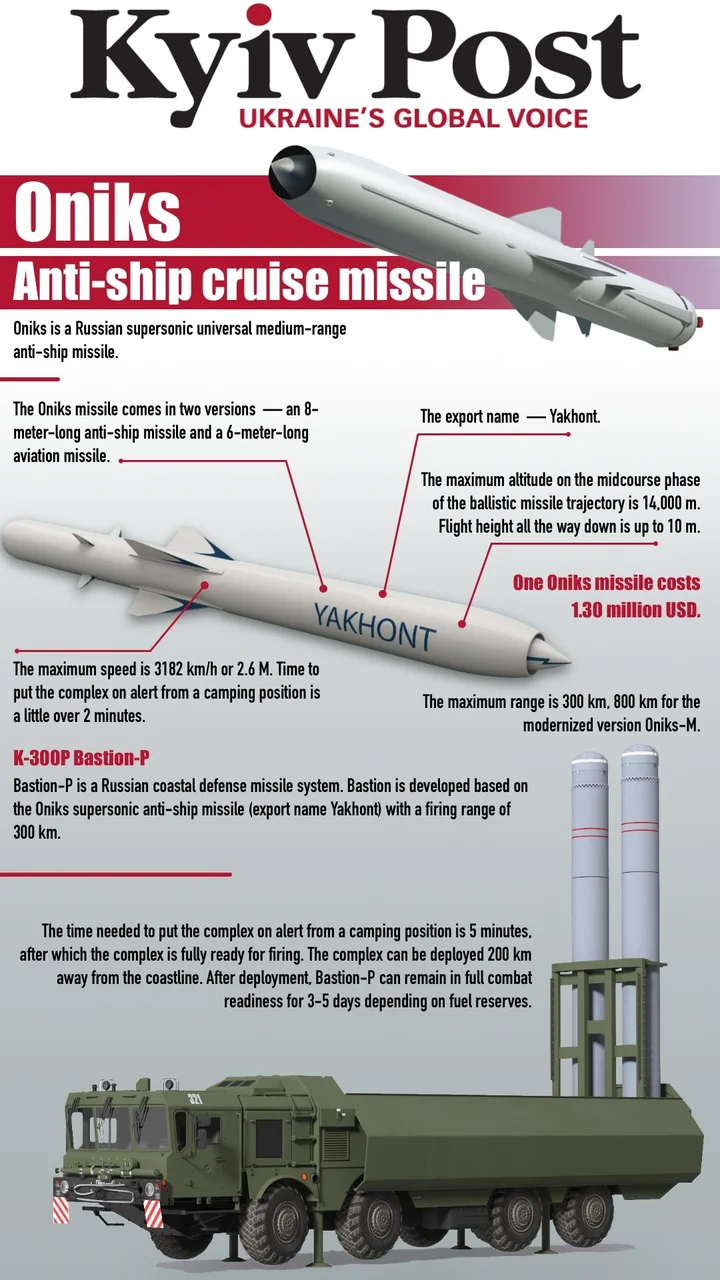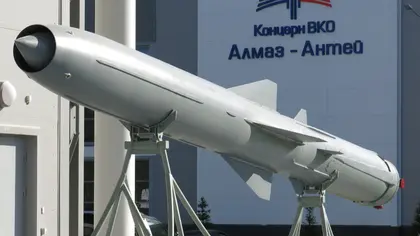Once again, Russia attacked Odesa. After the so-called “grain agreement” was broken on July 17, Odesa became the target of massive missile strikes. Almost every night since July 18, Russia has been launching missiles at the city’s port infrastructure and Odesa’s downtown.
This time the Russians attacked the city with Kh-22, Kh-59, Kalibr and Onyx missiles. The port infrastructure of Odesa and Chornomorsk, which were involved in grain exports, was badly damaged. Nearly 60,000 tons of grain ready for shipment were destroyed, along with a warehouse with peas. Missile attacks on civilian infrastructure, ports, and grain terminals are another Russian war crime in Ukraine.
JOIN US ON TELEGRAM
Follow our coverage of the war on the @Kyivpost_official.
History
Onyx missiles were created in the early 1970s in the Soviet Union. According to the development plan, the new missile was to become a universal weapon for submarines, ships, boats, aircraft, and shore-based launchers. In terms of its versatility, Onyx was supposed to surpass the American “Harpoon” anti-ship missile system. Even then, this Soviet missile was capable of hitting targets at distances of up to 300 km.

The Onyx anti-ship missile was designed to be a universal missile: It has shared compatibility with aviation, navy, and ground forces; and it has the ability to strike not only ships at sea but also targets on land. A similar system concept is used in the Soviet S-300 anti-aircraft system — they were developed with the capability to engage both aerial and terrestrial targets.

Interview With an Expert: The Future of Ukraine’s Maritime Industry – the ‘Greek Model’
In 2019, Russia upgraded the Onyx missile and presented the Onyx-M, its modified version. It has enhanced precision in hitting both aerial and terrestrial targets and can fly at a maximum range of up to 800 kilometers. The missile also became more resistant to the effects of electronic warfare.
Onyx — what kind of weapon is it and what is it capable of?
The Onyx anti-ship missile has a wide range of settings, different flight trajectories, full unification with multiple delivery vehicles, and resistance to electronic warfare. Onyx is a 'fire-and-forget' type of missile, meaning it navigates to the target after launch without further input from the operator/launch vehicle.
After launch, the missile reaches an altitude of up to 14 kilometers and cruises there for most of the flight profile. In the midcourse phase of the ballistic missile trajectory, the missile uses an inertial guidance system to navigate toward its target and develops a maximum speed of 2.6 Mach (3,200 km/h). [Mach 1.0 is the speed of sound through the air and varies with altitude/temperature. At sea level it is 1,225 km/h, at high altitude it is 1,062 km/h.]
As the missile comes within about 120 kilometers, it descends to 10-15 meters above surface level and continues using its internal inertial navigation system to guide itself toward the target. [This type navigation relies and gyroscopes and has no external satellite or other positional data input, which contributes to inaccuracy.] For anti-ship employment the missile uses an active radar within to acquire above water ship components in the general vicinity of its inertial navigation course.
During the final phase of the trajectory, the missile descends to 5-10 meters over water and reduces its speed to 2 Mach (2450 km/h).
These technical flight characteristics make the Onyx missile a hard target for our air defense. The flight altitude of 10-15 meters is too low for radars to detect the target in time. This, in turn, leaves a limited amount of time to shoot down the missile after it has been spotted. One should also remember that Onyx is almost three times faster than Kalibr. Ukrainian S-300 air defense systems can spot a target of this size at an altitude of up to 15 meters only from a distance of 21 kilometers – the Onyx will take about half a minute to cover this distance.
“For more accurate calculations, it is necessary to add the time needed to detect a fairly small object, capture it, the time to take and process a decision, as well as the time to launch the anti-aircraft missile itself, and the time it will take to reach the target. It is also important to account for the channelization of air defense systems, that is, for the number of objects that the complex can simultaneously attack, as well as the total number of weapons,” – reports Defense Express.
Russia started using these missiles precisely because of their technical characteristics, in particular, high speed and ultra-low flight altitude – a combination of these factors ensure their low visibility for our air defense systems. Unfortunately, Russia inherited a significant number of these missiles from the USSR.
Depending on a specific modification and purpose, the mass of the Onyx missile warhead may vary. For example, in the most common model of the Onyx anti-ship missile, the mass of the warhead is approximately 200-250 kilograms.
Although Onyx is primarily considered to be an anti-ship missile, it has never been used to hit water targets. Instead, missiles are used to strike terrestrial targets.
How to counter Onyx effectively?
Yuriy Ignat, the spokesperson of the Air Force Command, said “it is hardly possible to shoot down a missile flying at such a speed and at such a low altitude with the means at our hands.” He also said that this missile can be “influenced using electronic warfare” and added that not all missiles reach their target.
It is highly probable that the MIM-104 Patriot air defense system and the French SAMP/T anti-missile defense system would be effective against Onyx missiles. Although the SAMP/T was developed primarily against ballistic targets, it can also be successful against low-flying cruise missiles. These anti-aircraft systems have already successfully demonstrated their effectiveness by destroying hypersonic Kinzhal sand Iskanders.
For three nights – July 18, 19, and 20 – Odesa was attacked with missiles launched by Russian forces from Bastion coastal missile complexes in Crimea. These complexes were placed on the territory of the annexed peninsula back in 2015.
Ukraine knows the approximate location of the Russian Bastions, as well as their maintenance and rearmament bases. It seems that it’s more effective to neutralize the threat on the ground than to intercept it in the sky.
To destroy the entire launch facility or warehouse of missiles on the ground, before the Onyx is launched, Ukraine needs long-range, precision weapons, as well as data from satellites.
The solution to make the destruction of Russian missiles more effective is to increase the number of powerful anti-missile defense equipment in the Ukrainian military.
The spokesperson for the Air Force said that it’s necessary to strengthen the southern regions and port cities, with anti-ballistic weapons such as the Patriot or SAMP/T systems. It will help solve the problem of destroying complex, elusive targets like the Onyx and Kh-22.
You can also highlight the text and press Ctrl + Enter










